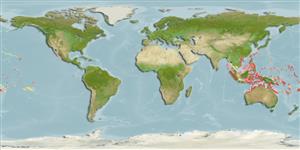Common names from other countries
>
Blenniiformes (Blennies) >
Blenniidae (Combtooth blennies) > Blenniinae
Etymology: Meiacanthus: Greek, meion = less = lessen + Greek, akantha = thorn (Ref. 45335).
Environment: milieu / climate zone / depth range / distribution range
Ökologie
seewasser riff-verbunden; tiefenbereich 0 - 18 m (Ref. 58018). Tropical; 30°N - 22°S
Western Pacific: Moluccas and the Philippines east to Samoa, north to Ryukyu Islands, south to Rowley Shoals in Western Australia and the northern Great Barrier Reef and Tonga; Palau (Belau) in Micronesia.
Size / Gewicht / Alter
Maturity: Lm ? range ? - ? cm
Max length : 6.5 cm TL Männchen/unbestimmt; (Ref. 90102)
Rückenflossenstacheln (insgesamt) : 5 - 6; Rückenflossenweichstrahlen (insgesamt) : 22 - 25; Afterflossenstacheln: 2; Afterflossenweichstrahlen: 15 - 18. Males with long filaments from the tips of the tail (Ref. 48636).
Adults are found on reef slopes with large soft-coral communities (Ref. 48636). They form groups usually among gorgonians or black coral (Ref. 90102) in shallow protected reefs. Relatively common and broadly distributed. Feed on zooplankton. Oviparous. Eggs are demersal and adhesive (Ref. 205), and are attached to the substrate via a filamentous, adhesive pad or pedestal (Ref. 94114). Larvae are planktonic, often found in shallow, coastal waters (Ref. 94114). Minimum depth from Ref. 58018.
Life cycle and mating behavior
Maturities | Fortpflanzung | Spawnings | Egg(s) | Fecundities | Larven
Oviparous, distinct pairing (Ref. 205).
Myers, R.F., 1991. Micronesian reef fishes. Second Ed. Coral Graphics, Barrigada, Guam. 298 p. (Ref. 1602)
IUCN Rote Liste Status (Ref. 130435)
CITES (Ref. 128078)
Not Evaluated
Nutzung durch Menschen
Tools
Zusatzinformationen
Download XML
Internet Quellen
Estimates based on models
Preferred temperature (Ref.
115969): 25.7 - 29.3, mean 28.5 (based on 1738 cells).
Phylogenetic diversity index (Ref.
82804): PD
50 = 0.5000 [Uniqueness, from 0.5 = low to 2.0 = high].
Bayesian length-weight: a=0.00562 (0.00258 - 0.01228), b=3.06 (2.87 - 3.25), in cm Total Length, based on LWR estimates for this (Sub)family-body shape (Ref.
93245).
Trophic level (Ref.
69278): 3.4 ±0.45 se; based on food items.
Widerstandsfähigkeit (Ref.
120179): hoch, Verdopplung der Population dauert weniger als 15 Monate. (Preliminary K or Fecundity.).
Fishing Vulnerability (Ref.
59153): Low vulnerability (10 of 100).
